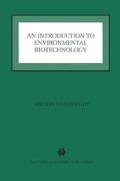Abstract
We saw in Chapter 1 that microorganisms play a dominant role in trans- forming pollutants that reach the environment. This ability results from the fact that microorganisms exhibit an extremely wide metabolic diversity and are thus able to degrade an equally wide variety of chemical compounds. However, since many pollutants are cellular poisons it is not surprising to find that they also inhibit both microbial growth and activity. Microbial activity is responsible for the major cycling of elements in the environment so any impairment of microbial growth will necessarily have negative effects on microbial activity. Major transformations, such as nitrogen fixation, nitrification and carbon mineralization may be impaired as a result of pollutant impact. It should also be remembered however, that microorganisms also often use pollutants as nutrient sources, a fact that can lead to major, often unchecked and uncontrolled growth of microbial biomass. In terms of the likely disturbance impact of a pollutant on the environment we can therefore recognize negative disturbance, where a pollutant inhibits an essential microbial process, and positive disturbance impact where a process is stimulated by pollutant impact. The increase in microbial populations following pollution impact can also be used as an indicator that pollution is occurring; the classic example being of course the increase in bacterial(coliforms) following sewage pollution of water courses.
Access this chapter
Tax calculation will be finalised at checkout
Purchases are for personal use only
Preview
Unable to display preview. Download preview PDF.
References
Wainwright, M. and G. M. Gadd 1997. Fungi and industrial pollutants. In D. T. Wicklow and B. Soderstrom(eds.), The Mycota IV, pp 85–97.
Johnen, B. G., and E. A. Drew. 1977. Ecological effects of pesticides on soil microorganisms. Soil Science 123: 309–324.
Somerville, L. and M. P. Greaves 1987. Pesticide Effects on Soil Microflora, London, Taylor and Francis.
Wellburn, A. 1988. Air Pollution and Acid Rain, New York, Longmans.
Mathy, P. (ed.) Air Pollution and Ecosystems. Dordrecht, Reidel.
Author information
Authors and Affiliations
Rights and permissions
Copyright information
© 1999 Springer Science+Business Media New York
About this chapter
Cite this chapter
Wainwright, M. (1999). Pollution-Effects on Microorganisms and Microbial Activity in the Environment. In: An Introduction to Environmental Biotechnology. Springer, Boston, MA. https://doi.org/10.1007/978-1-4615-5251-2_17
Download citation
DOI: https://doi.org/10.1007/978-1-4615-5251-2_17
Publisher Name: Springer, Boston, MA
Print ISBN: 978-1-4613-7394-0
Online ISBN: 978-1-4615-5251-2
eBook Packages: Springer Book Archive

